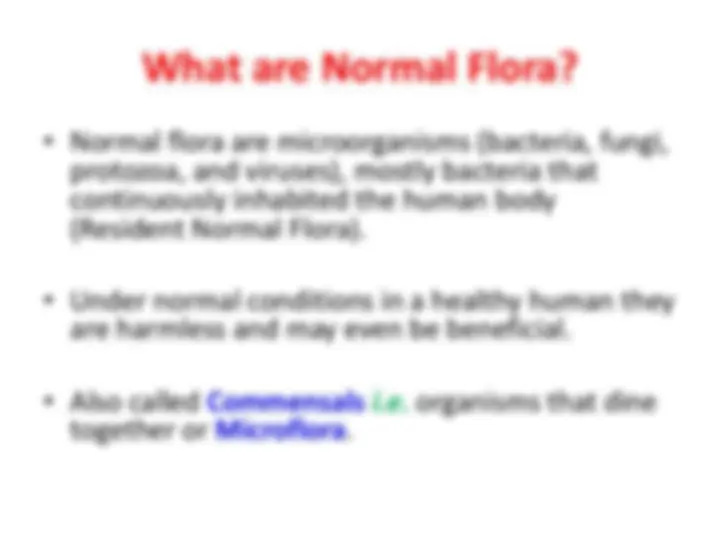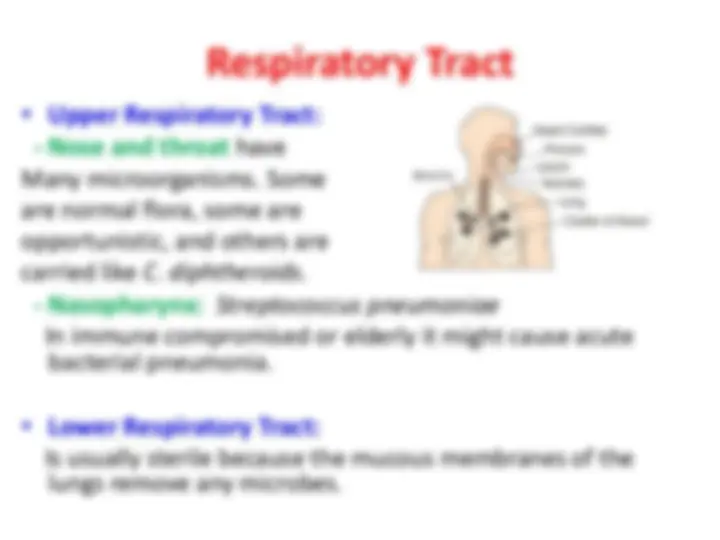Download Normal Flora and more Study notes Medical Microbiology in PDF only on Docsity!
Normal Flora
CLS 212 : Medical Microbiology
Relationships between Organisms
- Symbiosis Permanent association between two different organisms.
- Neutralism Two organisms living together, and neither is affected by that.
- Mutualism Two organisms living together, and both benefit from that.
- Commensalism: Two organisms living together, one is benefited and the other is not been affected.
- Parasitism: Two organisms living together, one is benefited ‘’called parasite’’ and the other is harmed ‘’called host’’.
- Synergism: Sometimes, two (or more) microorganism may work together “team up” to produce a disease that neither could cause by itself.
Stuff about Normal Flora
- A fetus is sterile when born (No Normal Flora), then newborn start having the normal flora from its mother, air, food and the environment.
- Our internal organs are sterile like the spleen, liver, pancreas, bladder, CSF, and blood unless during infection.
- Normal flora differ from one human to another depending on age, diet, and geographic habitat.
- When the number of resident normal flora is greatly reduced, opportunistic microbes can easily cause infections in these areas e.g. Candida albicans that cause candidiasis.
Transient Normal Flora
- Normal flora that are temporarily living on and within humans.
- The transient microbes living in the external environment are attracted to moist, warm body areas.
Why are these microbes temporary??
- They may be washed from external areas by bathing.
- They may not be able to compete with resident normal flora.
- They may be killed by substances produced by the resident normal flora.
- They may not survive in the acidic or alkaline pH of the site.
- They may be flushed away by bodily secretions like tears, sweat, oil, urine, feces,..).
Microflora of the SKIN
The resident micoflora of the skin consist
primerly bacteria and fungi
Resident bacteria of the skin can be in any layer
of the skin.
Skin can acquire any transient bacteria from the
environment but it either get washed off or die
because the skin is dry, has acidic pH, and
produce sweat and oil.
HCWs
HCWs must be particularly carful to keep there skin and •
clothing free of transient microbes as possible to prevent
personal infections and to avoid transferring pathogen to
patient
Microflora of the EYES
- The conjunctiva of the eye has
primarily S. epidermidis , followed
by S. aureus , C. diphtheroids , and
S. pneumoniae.
- Some skin normal flora are also
- present but at fewer amounts.
- Tears (Lysozyme enzyme), mucus, and oil will protect
the conjunctiva of the eye from colonization by more
bacteria.
Respiratory Tract
- Upper Respiratory Tract: - Nose and throat have
Many microorganisms. Some
are normal flora, some are
opportunistic, and others are
carried like C. diphtheroids.
- Nasopharynx: Streptococcus pneumoniae
In immune compromised or elderly it might cause acute
bacterial pneumonia.
Is usually sterile because the mucous membranes of the
lungs remove any microbes.
Oral Cavity (Mouth)
and anaerobic bacteria.
The most common ones are:
C. diphtheroides, S. aureus,
and S. epidermidis.
protozoa, and viruses can be living in the mouth.
Teeth and Gengiva: Streptococcus mutans
- Poor dental hygiene help bacteria to grow and cause
dental caries, gingivitis,...
- After dental surgeries, there might be a risk of
bloodstream infection that might cause endocarditis.
Microflora of the Gastrointestinal Tract
- Stomach: Only few bacteria are present in the stomach due to gastric enzymes and acidic pH.
- Small intestine: Only few normal flora are present in the upper part of small intestine because bile kills them. Lower parts have more no. of normal flora.
- Large intestine:
- Has more bacteria than any other part of the body. 99 % of normal flora in the large intestine are anaerobic Bacteroides spp. - Also many fungi, protozoa, and viruses can live there.
- Many of the normal flora are opportunistic i.e. if they move to other areas e.g. E.coli cause urinary infection.
Microflora of the Urogenital Tract
Urinary Tract
- Kidneys, Ureters and Urinary Bladder: are sterile.
- Lower Urethra and external opening: bacteria, yeast,
and viruses. Has the same bacteria present on the skin.
Genital Organs
- Male and female genitals: are sterile except vagina.
- Vagina: Lactobacillus spp. keeps the pH acidic to protect
the vagina from opportunistic infections e.g. fungal
vaginitis ( Candida albicans ) or bacterial vaginosis
( Bacteroides spp. , Gardnerella vaginalis ).
Harmful Effect of Normal Flora
- When the normal flora are displaced from their normal site of the body e.g. bloodstream infections by S. epidermidis.
- When potential pathogens gain a competitive advantage due to diminished populations of harmless competitors e.g. C. difficile growing in the gut after antibiotic therapy.
- When harmless, commonly ingested food substances are converted into carcinogenic derivatives by bacteria in the colon e.g. sweetener cyclamate.
- When individuals are immunocompromised, normal flora can overgrow and become pathogenic.






























